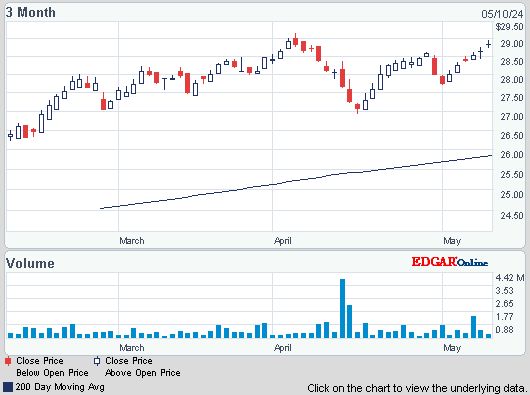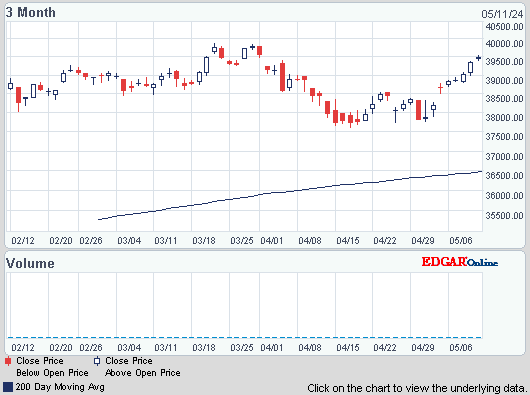Dow inched up 3, decliners over advancers 3-2 & NAZ rose 17. The MLP index was off 3 to the 434s (down 31 from its recent record high) & the REIT index slipped 1 to the 258s. Junk bond fund continued weak & Treasuries retreated. Oil & gold were marginally lower.
AMJ (Alerian MLP Index tracking fund)

After more than a decade of losing ground to China & other export powerhouses, US manufacturers are showing signs of regaining their competitive edge. The US deficit on trade of manufactured goods in this year's first half shrank to $225B from $227B a year earlier, according the Manufacturers Alliance for Productivity & Innovation. The improvement, while slight, came after years of ballooning deficits as the US lost manufacturing business to China, South Korea & other nations. The findings come as Boston Consulting Group (BCG), a leading proponent that US manufacturing will come roaring back, predicts a surge in US exports, partly helped by lower energy costs & stagnating wages. In its report, BCG says rising exports & "reshoring" of production to the US from China "could create 2.5 million to five million American factory and service jobs associated with increased manufacturing" by 2020. That, BCG says, could reduce the unemployment rate, currently 7.4%, by as much as 2-3 percentage points. The overall U.S. trade deficit, meanwhile, narrowed recently, as new shale-drilling technologies have sharply boosted domestic energy production. About 12M Americans are directly employed by manufacturers, down from nearly 17M just 2 decades ago.

Photo: Bloomberg
Home sales probably increased in Jul to the highest level in more than 3 years as growing demand for residential real estate bolsters the expansion, according to recent predictions. Combined purchases of existing & new homes climbed to a 5.6M annualized pace last month, the fastest clip since Nov 2009, according to the latest forecast in a Bloomberg survey. Improving sales, even as borrowing costs rise, & a limited supply of homes, lots & materials are helping boost home values & builder confidence. The waning effects of across-the-board federal spending cuts, combined with gains in the housing & auto markets, will probably help lift economic growth in H2. Sales of previously owned homes rose to a 5.15M annualized pace last month from 5.08M in Jun, according to the latest median forecast & the Commerce Dept data will probably show purchases of new homes cooled to a 487K pace in Jul after reaching a 5-year high 497K the month before. Homebuilder confidence climbed in Aug to the highest level since Nov 2005 as supply constraints & rising prices help boost the outlook for builder revenue. Sales are expected to increase an average 37% among 10 US homebuilders in Q3.
Saks' Q2 loss widened, burdened by some higher expenses & charges as it faced higher markdowns of some goods & misjudged the timing of a key seasonal clearance sale. Adjusted results & revenue fell short of estimates. SKS, which is being acquired by Hudson's Bay in a $2.4B deal, EPS was a loss of 13¢, which compares with 8¢ forecasted. The qtr included $5.2M in charges tied to store closing costs, acquisition-related costs & other items. Stripping these out, the EPS loss was 10¢ versus the predicted 8¢. Selling, general & administrative expenses rose to $210M from $190M. Gross margin fell to 36.6% from 37.2%. CEO Stephen Sadove said that the decline was mostly because the company had to take increased markdowns in men's, women's shoes & handbags. He also said that delaying the start of Saks' end-of-spring clearance sale hurt its sales & gross margin. Revenue edged up 1% to $708M from $704M & compares with expected revenue of $732. Revenue at stores open at least a year climbed 1.5%. But this was slower growth than a year ago, when it posted a 4.7% increase. Sadove said that some of the strongest categories included women's contemporary & advanced designer clothing, dresses, women's shoes, handbags, fragrances, children's clothing, men's accessories, shoes & contemporary clothing. The stock lost a couple pennies.
Saks 2Q performance misses analysts' estimatesAP

There is generally little activity in the last 2 weeks of Aug with many traders away. But Egypt is a mess & nobody knows what to do. It's near the MidEast oilfields & has the Suez canal, an important shipping lane. In the meantime, the traders remaining are biting their fingernails, trying to figure out what the Federal Reserve will do next month. Traditional yield sectors continue to see selling, not a good sign for the overall stock market.
Dow Jones Industrials

AMJ (Alerian MLP Index tracking fund)
Treasury yields:
U.S. 3-month |
0.04% | |
U.S. 2-year |
0.35% | |
U.S. 10-year |
2.86% |
| CLU13.NYM | ....Crude Oil Sep 13 | ...107.18 | (0.3%) |
| GCQ13.CMX | ...Gold Aug 13 | ........1,373.00 | (0.1%) |
After more than a decade of losing ground to China & other export powerhouses, US manufacturers are showing signs of regaining their competitive edge. The US deficit on trade of manufactured goods in this year's first half shrank to $225B from $227B a year earlier, according the Manufacturers Alliance for Productivity & Innovation. The improvement, while slight, came after years of ballooning deficits as the US lost manufacturing business to China, South Korea & other nations. The findings come as Boston Consulting Group (BCG), a leading proponent that US manufacturing will come roaring back, predicts a surge in US exports, partly helped by lower energy costs & stagnating wages. In its report, BCG says rising exports & "reshoring" of production to the US from China "could create 2.5 million to five million American factory and service jobs associated with increased manufacturing" by 2020. That, BCG says, could reduce the unemployment rate, currently 7.4%, by as much as 2-3 percentage points. The overall U.S. trade deficit, meanwhile, narrowed recently, as new shale-drilling technologies have sharply boosted domestic energy production. About 12M Americans are directly employed by manufacturers, down from nearly 17M just 2 decades ago.
- U.S. Manufacturers Gain Ground The Wall Street Journal

Photo: Bloomberg
Home sales probably increased in Jul to the highest level in more than 3 years as growing demand for residential real estate bolsters the expansion, according to recent predictions. Combined purchases of existing & new homes climbed to a 5.6M annualized pace last month, the fastest clip since Nov 2009, according to the latest forecast in a Bloomberg survey. Improving sales, even as borrowing costs rise, & a limited supply of homes, lots & materials are helping boost home values & builder confidence. The waning effects of across-the-board federal spending cuts, combined with gains in the housing & auto markets, will probably help lift economic growth in H2. Sales of previously owned homes rose to a 5.15M annualized pace last month from 5.08M in Jun, according to the latest median forecast & the Commerce Dept data will probably show purchases of new homes cooled to a 487K pace in Jul after reaching a 5-year high 497K the month before. Homebuilder confidence climbed in Aug to the highest level since Nov 2005 as supply constraints & rising prices help boost the outlook for builder revenue. Sales are expected to increase an average 37% among 10 US homebuilders in Q3.
Saks' Q2 loss widened, burdened by some higher expenses & charges as it faced higher markdowns of some goods & misjudged the timing of a key seasonal clearance sale. Adjusted results & revenue fell short of estimates. SKS, which is being acquired by Hudson's Bay in a $2.4B deal, EPS was a loss of 13¢, which compares with 8¢ forecasted. The qtr included $5.2M in charges tied to store closing costs, acquisition-related costs & other items. Stripping these out, the EPS loss was 10¢ versus the predicted 8¢. Selling, general & administrative expenses rose to $210M from $190M. Gross margin fell to 36.6% from 37.2%. CEO Stephen Sadove said that the decline was mostly because the company had to take increased markdowns in men's, women's shoes & handbags. He also said that delaying the start of Saks' end-of-spring clearance sale hurt its sales & gross margin. Revenue edged up 1% to $708M from $704M & compares with expected revenue of $732. Revenue at stores open at least a year climbed 1.5%. But this was slower growth than a year ago, when it posted a 4.7% increase. Sadove said that some of the strongest categories included women's contemporary & advanced designer clothing, dresses, women's shoes, handbags, fragrances, children's clothing, men's accessories, shoes & contemporary clothing. The stock lost a couple pennies.
Saks 2Q performance misses analysts' estimatesAP
Saks (SKS)
There is generally little activity in the last 2 weeks of Aug with many traders away. But Egypt is a mess & nobody knows what to do. It's near the MidEast oilfields & has the Suez canal, an important shipping lane. In the meantime, the traders remaining are biting their fingernails, trying to figure out what the Federal Reserve will do next month. Traditional yield sectors continue to see selling, not a good sign for the overall stock market.
Dow Jones Industrials










No comments:
Post a Comment